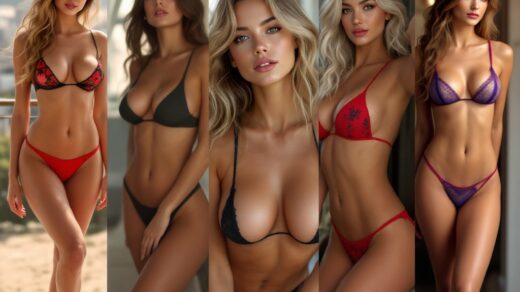The dawn of artificial intelligence has dramatically transformed numerous creative domains, including the realm of erotic art. Among the avant-garde methods making waves is the deployment of diffusion models, an advanced technique that injects a fresh dose of mathematical precision into artistic generation. These models ingeniously convert chaotic noise into mesmerizing and cohesive visuals, effectively reshaping the frontiers of artistic expression. Particularly intriguing is the way these models seamlessly weave in themes of sensuality, allowing for a vibrant exploration of human desires and sexual imagery through art. The fusion of mathematical logic with visual beauty not only amplifies creativity but also sparks pivotal conversations about ethics and representation. Thus, delving into the mathematical essence of diffusion models offers a robust technical and philosophical perspective on the creation of contemporary erotic art.
Understanding Diffusion Models
Diffusion models are deeply rooted in statistical methodologies, empowering artists and coders alike to chart the unpredictable terrains of art. This part intends to unravel the fundamental principles and complexities of these models to better grasp their influence. Essentially, these models elucidate how data spreads and transforms over time, rendering them exceptionally apt for creating art. The notion of noise is central, serving as the raw input that morphs into a more refined structure. The expansive mathematical groundwork includes critical elements like variance and the signal-to-noise ratio, which dictate the caliber of the eventual image produced. Through this comprehension, we gain insight into how abstract numerical concepts evolve into stunning artistic creations.

The Basics of Diffusion Theory
- Randomness and Variation: The genesis of art creation in diffusion models hinges on dealing with chaotic noise, sculpting it into a coherent masterpiece.
- Mathematical Foundations: Core principles such as variance steer the degree of deviation from a central theme during image crafting.
- Signal-to-Noise Balance: This balance is vital, impacting the sharpness and detail of the generated visuals, thereby affecting the fidelity of the final product.
Application of Diffusion Models in Erotic Art
Diffusion models have invigorated the artistic process, unlocking new paths for artists to convey erotic themes. Their inherent adaptability empowers creators to play with styles and emotional depth that might have been limited by older methods. As a result, the sphere of erotic art is now more dynamic and varied than ever. The uses extend beyond image creation, shaping how audiences engage with artworks and their themes. The incorporation of artistic styles into the diffusion model process enriches the nuances of erotic storytelling. The transformation of concepts into tangible visuals is not merely an artistic pursuit but also a mathematical one.
Crafting Artistic Styles
With user-defined settings, diffusion models can mirror various artistic trends, breathing new life into erotic subjects. Creators outline features they wish to explore, which the models then translate into visually captivating art pieces. This versatility fosters creations that evoke a range of emotional interactions, underscoring the multifaceted nature of art interpretation. Furthermore, the dialogue between human ingenuity and algorithmic output spurs an endless cycle of innovation.
| Artistic Movement | Key Traits | Effect on Erotic Themes |
|---|---|---|
| Impressionism | Gentle brushstrokes, light dynamics | Highlights ephemeral moments of affection |
| Surrealism | Dream-like imagery, unusual contrasts | Provokes questioned views of sexuality |
| Abstract | Non-realistic forms, vivid hues | Emphasizes emotive rather than realistic expression |
Ethical Considerations in AI-Driven Erotic Art
Though diffusion models encourage artistic liberty, they also raise critical dialogues about moral obligations. It’s paramount to maintain a balance between innovation and ethical norms to ensure the art honors those depicted. The risk of misrepresentation in erotic art is considerable, necessitating a diligent approach from creators. As artists adventure into this field, addressing concerns about consent and portrayal becomes crucial. By setting standards and participating in open dialogues, the artistic community can champion responsible and respectful art-making practices.
Advantages of Using Diffusion Models
Diffusion models are increasingly preferred for several reasons, making them ideal for generating erotic art. Their unparalleled ability to produce exceptional quality outputs often results in images with extraordinary detail. This high precision enables audiences to form profound connections with the artwork. Moreover, the adaptability of these models provides artists with abundant options for personalization. The freedom to experiment across various genres and styles is groundbreaking, paving new paths to diverse and immersive experiences. Artists now have the opportunity to expand the horizons of erotic art.

Superior Quality Outcomes
- Clarity: The models produce images with notable resolution, capturing fine details.
- Organic Characteristics: The results often present natural textures and seamless forms.
- Visual Attraction: High-caliber outputs draw a wider audience, enhancing artist exposure.
Challenges and Limitations
Despite their myriad benefits, utilizing diffusion models brings certain hurdles to light. The computational demands can be intensive, necessitating advanced infrastructure and substantial processing time. This requirement can exclude artists lacking sophisticated technology from accessing these tools. Additionally, biases embedded within AI systems can sustain stereotypes, impairing the intended expression of erotic themes. As the art community progresses, tackling these issues is essential to ensure technology boosts rather than compromises artistic authenticity.
Bias and Distortion
- Data Prejudice: Inherent biases in data sets may lead to skewed depictions in the generated art.
- Impact on Society: Misinterpretations might reinforce damaging stereotypes in erotic themes, shaping cultural perceptions.
- A Need for Vigilance: Artists and developers must remain alert to avoid unintended outcomes from AI-generated works.
Conclusion
The mathematics powering diffusion models heralds a pivotal change in the realm of erotic art production. By bridging technology and human creativity, these models unlock fresh imaginative horizons. The promise of high-quality, varied, and ethically-minded artworks is immense. As the field continues to advance, the merging of intricate mathematical blueprints with artistic effort will continue to challenge and redefine existing limits. The prospect of erotic art appears not just lively but multidimensional, owing to the strides achieved through diffusion models, encouraging artists to explore and innovate on an unprecedented scale.
FAQ
- What are diffusion models?
Diffusion models are algorithms that create visuals by gradually refining random noise into cohesive images, frequently utilized in generative art. - How do diffusion models produce erotic art?
They harness mathematical methods to convert noise into artistic depictions, customized to specific themes, including eroticism. - Are there ethical considerations in AI-generated erotic art?
Yes, ethical considerations encompass issues like consent and depiction, which are critical when crafting images that delve into sensitive topics. - What benefits do diffusion models have over traditional approaches?
They provide superior quality outputs and enhanced flexibility for creating a wide array of artistic styles. - What obstacles do creators encounter when utilizing diffusion models?
Hurdles include significant computational needs and inherent biases in AI interpretation and depiction of erotic themes.


